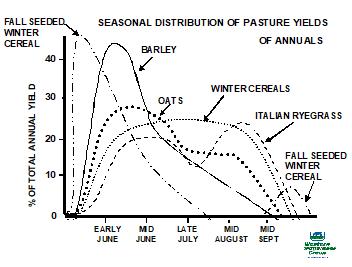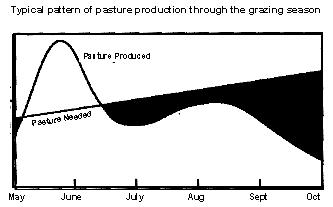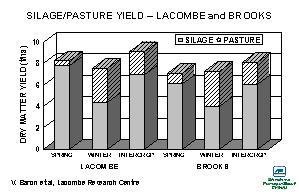| | Introduction | Conclusions
.
Introduction
Annual crops are an excellent method of adding flexibility to a livestock operation by providing supplemental or emergency pasture for grazing livestock. They can also be utilized to extend the grazing season in the fall, spring or both the fall and the spring. Annuals give producers the flexibility to add pastures quickly when needed. Any annual crop can be utilized for annual pastures providing it is palatable and nutritious to livestock. These crops can be any of the species that produce sufficient growth throughout the growing season to provide forage, such as spring cereals, winter cereals or corn. Crops that may be perennials such as the ryegrasses can be used as annuals, since their lack of hardiness allows them to only produce the year of seeding before winter killing. These crops can be either grazed green during the summer months, fall or spring grazed or stockpiled for winter grazing, either standing or swath grazed.
The most prevalent crops used for grazing are cereals - either winter or spring. They are the least expensive to grow, widely adapted, easy to manage, commonly available and generally very productive, making them a low risk annual forage crop. Spring cereals are not best adapted to summer grazing as they produce the majority of their growth early in the season and have poorer regrowth than some crops. They are hard to manage and maintain in their vegetative state for good pasture purposes and tend to produce stem and seed heads which are not preferred by grazing livestock. Figure 1 indicates that the majority of their production is from mid to late June. This generally makes them a poor choice as a supplemental pasture with perennials because perennials are very productive during this same period. A typical perennial pasture generally requires supplementation during the mid summer and fall (Figure 2) when the growth has slowed or the plant has reached dormancy. The most common spring cereals used for grazing are oats, barley and triticale.
Winter cereals seeded in the spring tend to be more productive during the summer months (Figure 1). They require a vernalization period to produce seed and when spring seeded, these crops remain in the vegetative state and produce only leaf material. This makes them very easy to manage for grazing. Winter cereals are more productive under intensive grazing management systems than when grazed continually. The quality of the winter cereals can easily be 20% protein and 75% digestibility. Research at the Lacombe Research Centre as well as the Western Beef Development Centre at Saskatoon have shown livestock gains to be very high when grazing winter cereals. These crops make not only ideal summer pastures but they maintain their growth and quality well into the fall, making them ideal for extending the fall grazing period. The most common winter cereals for grazing are fall rye, winter triticale and winter wheat.

Figure 1.
Ryegrass is another common annual used for grazing. Ryegrass is not very drought tolerant and in areas of low moisture should not be considered. Ryegrass grows and regrows very quickly which makes it ideal as a pasture grass. Some ryegrasses are short-lived perennials and some are annuals. In Western Canada they are all annuals since they tend not to have sufficient winter hardiness to withstand the winters. Ryegrass is small seeded like most grasses and when seeded in the spring it grows slowly initially until it becomes established and then grows very quickly. When managed under an intensive management system ryegrass can be very productive. The fact that the crop has little or no dormancy makes it an ideal fall pasture as it continues to grow and maintain its quality well into the fall, making them useful in extending the grazing season.

Figure 2 .
Corn is a crop that is being used as a grazing crop. Corn has been developed as a grain or silage crop. In most areas of the prairies there is not sufficient "corn heat units" (CHU) to grow corn as a grain crop. As a silage crop there are not sufficient CHUs in much of the prairies to produce the high yields associated with corn for silage. Without sufficient heat units, corn yields are generally not much better than spring cereals (Table 1). The grain portion of the corn adds around 50% of the yield to the silage mix. When the grain is not sufficiently filled, the yields are reduced drastically. There is some value to corn as a crop for fall or winter grazing. The quality of the corn leaves and stalks are high. The corn stands erect and can easily be grazed if electric fencing is used to limit livestock access. The corn requiring the least amount of heat units should be chosen to ensure as much growth and maturity as possible in areas of low corn heat units. The cost of growing and utilizing corn for winter grazing makes this crop less attractive than growing cereals for swath grazing (Table 2). New glyphosate tolerant varieties reduce the problems associated with good weed control.
Table 1. Corn Yields in Comparison to Spring Cereals - Lacombe & Brooks (t/ac) - 1999 | Table 2. Grazing Corn vs Swath Grazing1 |
| |
Turnips have attracted interest as a grazing crop. Not only are the tops usable for grazing but they also produce tubers that can be grazed by cattle as well. The crop can be grown using traditional cropping equipment and is managed much the same as canola. The crop is very high in moisture (88 - 90%), which may have an affect on intake. It is also low in fibre and straw should be fed with this crop to supply some fibre for the livestock. Dry matter yields of turnips are generally not much different than cereals. Turnips do have the capability to have their tops grazed and allowed to regrow for fall grazing when the perennials have gone into dormancy. Both the tops and tubers can be grazed. Turnips may contain an amino acid compound S-methylcysteine sulphoxide (SMCO) which accumulates in brassicas and can cause hemolytic anemia and goitre. Grazing the tubers may also cause choking if the animals try to swallow tubers or tuber pieces that are too large.
Table 3. Quality of intercropped silage

Intercropping spring cereals with either winter cereals or ryegrasses provide a crop which can be harvested for silage or greenfeed and allowed to regrow for fall grazing. The high quality of the leaf material from the winter cereals will increase the quality of the silage or greenfeed (Table 3). When allowed to regrow the winter cereals or ryegrass will provide a high quality pasture that can be grazed until covered with snow. Winter triticale and fall rye are more productive during the fall months than is winter wheat. Under good moisture or irrigation the ryegrass grows well in the fall as well. These crops are capable of withstanding frosts and still maintain their green color and quality.
When grown together, the silage crops may suffer some yield loss but the silage and pasture yields together have been shown to produce more forage per acre than either one grown separately (Figure 3).

Figure 3.
The regrowth from the intercrop yielded higher than the spring or winter cereal seeded alone. The fall regrowth for the spring cereals alone is much less than the regrowth from the spring and winter cereals grown together.
Swath grazing is another method of utilizing cereals for fall and winter grazing. These crops can be seeded in the spring (early to mid June), swathed in the fall and grazed in the fall, winter or spring. Research at Lacombe has shown that seeding the spring cereals too late in June can reduce yields dramatically.
Oats out yielded the other crops and all had a 10% decrease in digestibility from time of harvest to April. The quality of the crops in April was very high and capable of supporting a lactating cow in April. This makes swath grazing a practical method of utilizing spring cereals for extending the grazing period from fall through to spring.
Table 4. Crop Yields and digestibility losses over winter

Conclusions
Annuals make excellent pasture crops and can be utilized not only through the growing season, but also throughout the year to extend the grazing season. Growing annuals for pasture is generally more expensive than utilizing perennials for pasture. Annuals can provide producers with the ability to graze crops when they would traditionally be feeding stored feeds. This reduces the harvesting, handling, feeding and manure disposal costs. Annuals give the producer more flexibility within their livestock operation.
Arvid Aasen, Forage and Pasture Agronomist (retired)
Western Forage/Beef Group
Lacombe Research Centre
Lacombe, Alberta |
|